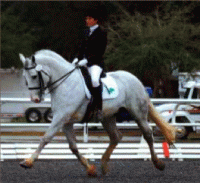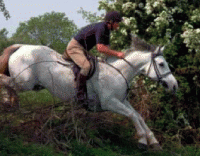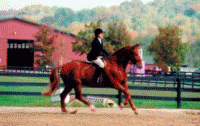The Irish Draught Horse: A Horse for all Seasons



The unique qualities of temperament, soundness and ability have been bred into the Irish Draught over hundreds of years of galloping across the Irish countryside.
By Judie Framan
Photography by Elliot Framan
“It is difficult to name one compelling trait of the Irish Draught,” says Rachael Cox, Information Officer of the Irish Draught Society of North America (IDHSNA). “The whole package is a delightful one; kindness, willingness, tremendous ability to do the job you ask, and humor, very important to an Irish Draught. Simply put, they are great horses to be with, work with and live with.”
Some of the best horsemen in the world have testified to the outstanding qualities of the Irish horse. The unique qualities of temperament, soundness and ability have been bred into the Irish Draught over hundreds of years of galloping across the Irish countryside. This makes them capable of doing anything you want them to do, from dressage to jumping, from hunting to eventing, and even everyday leisure riding. They are intelligent, quick to learn, safe, reliable, and they take care of their riders. People who own Irish Draughts agree that these traits are unequaled by any other breed of horse in the world. To explain how this came to be, let's take a step back in time.
Irish Draught Horse History
Ireland has long been known as the land where horse is king, and the special relationship that the Irish have with their horses is legend. Irish horses date back to the 10th century. In those days the small native horses were crossed with Norman warhorses to develop a larger, more substantial animal. Later these horses were crossed with Spanish Andalusians, which added refinement to the breed.
For centuries, Ireland has been predominantly an agricultural country, and the Irish Draught is a testament to the Irish farmer’s innate and uncanny ability for horse breeding. While the first references to the Irish Draught date back to the end of the 18th century, the breed was not formally established until 1917.
Unlike English farmers who, stimulated by the demands of British agriculture, bred heavier work horses such as the Shires, Clydesdales or Percherons, the Irish farmer needed a different kind of horse because the farming conditions in Ireland were much different.
In the late 19th century, Irish farmers began to develop a lighter more adaptable animal. Inspired breeding over the years produced a horse that could work the land, take the product to market, go fox hunting on Saturday and take the family to church on Sunday-- a horse with stamina, good bone, and exceptional temperament. Thus the Irish Draught (pronounced “draft”) was born a horse of the countryside, a product of his environment, but not a distinctive breed in the way that the European farm horses are. This race of horses has no foundation sires, early breeding records or studbook.
English horse dealers who came to Ireland to purchase the Irish horses gave them the name Irish Draught. The term draught horse was used by the English to describe farm horses, but it was also applied to the Irish horses even though they have very different characteristics. When one thinks of the word draught, it conjures up two distinct images, a mug of Irish beer, or an equine with a huge body and feet the size of dinner plates, suited only to pulling a plow. In this case, the term draught horse is about as applicable to the Irish Draught as it is to the Thoroughbred.
The economic instability in Ireland in the early 20th century, and the introduction of machinery on Irish farms diminished the unique agricultural niche that allowed the Irish Draught to flourish. These factors, coupled with the superb ability of the Irish Draught to produce cross bred foals that were more valuable economically than the purebred foals, led to a serious decline in numbers, and near extinction of the breed.
In 1976 a group of dedicated Irish Draught breeders, realizing that these jewels of the equine world must not be lost, came together at the West End Bar in County Cork. Like all serious things Irish, the fate of the Irish Draught was discussed over many pints that day. In the end, it was decided to form a society to “preserve, promote and improve the Irish Draught.” Thus, the Irish Draught Horse Society (IDHS) Limited was formed. Today, though still considered an endangered breed, the Irish Draught is enjoying growing popularity worldwide, and has played a major role as the foundation breed of the Irish Sport Horse. There are affiliated groups of IDHS throughout Ireland, as well as in Great Britain, New Zealand, Australia, Canada, the United States and Germany.
Versatility and Temperament
The Irish Draught is prized for its easy-going temperament and tremendous ability to jump, both of which are legacies of their hunting background. While we often see images of lush, verdant Irish countryside that dazzle the eye, fox hunting takes place over some of the most physically challenging terrain in the world. When out hunting, Irish horses are expected to negotiate stone walls, gates, fences, huge ditches and steep banks, most often at breakneck speed. Navigating this punishing environment takes a horse with stamina and strength, one that can carry its rider and itself safely.
“Because of its incredible temperament, intelligence, and sane mind, the Irish Draught is easy to train and learns quickly, and their uncanny jumping ability makes them uniquely versatile,” said Rachael Cox, “Raw talent accounts for the success of the Irish Draught in any equestrian discipline. The better the rider, the better the horse will respond, so there is really no reserve on their achievements. The bonus is that these horses love every minute of it.”
The latest trend in the show jumping world has been towards warmbloods, and European and German breeds are indeed the most recognizable. However, the Irish Draught, which is a true warmblood in its own right, has not enjoyed the notoriety of the mainland breeds. In spite of this, they compete in every aspect of equestrian sport worldwide: show jumping, eventing, dressage, driving, Le Trek and endurance riding, and yet they’re quiet, people-oriented temperament make them an ideal family horse. In some countries the Irish Draughts are used as police horses.
“I have ridden many hunters over the years, but the Irish horses are more than I ever imagined,” says John Lang, MFH of the Golden Vale Hounds, County Tipperary, Ireland. “They have total confidence in you, and will be there for you whenever you ask. They look at you as if to say, “What would you like me to do?” And if they believe you know the answer, they are capable and willing to do it. I believe the Irish Draught horses are the best warmbloods in the world.”
Breed Characteristics
The Irish Draught is a breed of boldness and distinction. It is proud of bearing with a strong back, powerful hindquarters and a deep girth. Standing over a lot of ground, it has an exceptional and sound constitution, well-defined withers, sloping free-moving shoulders and an ample chest. Although strength is the obvious feature, the Irish Draught is not heavy or ponderous. A solid-bodied horse, it is supported on strong clean legs of good dense bone, and hooves that are generous and sound. The action of the Irish Draught is smooth, free-moving and straight with good hock flexion, and free-moving at the shoulders.
Large bold eyes set wide apart and long well set ears convey the winsome nature of the Irish Draught. The head is always generous and nicely proportioned, giving the horse a handsome appearance. Irish Draughts can be of any solid color, but gray seems to be the dominant color, followed by chestnut. This is due in part to the fact that the Irish have supplied remount horses to European and British armies for 200 years, and the military preferred black or dark bay horses because they were less obvious on the battlefield.
Often you see articles and advertisements about Irish horses that carry letter designations after the horse’sname. These letters refer to the various Irish horse registries. Registered Irish Draught (RID) denotes a horse that is registered as a purebred Irish Draught. Irish Draught Sport Horse (IDSH) denotes a horse that has at least 1/8 Irish Draught breeding. The Irish Sport Horse (ISH) is generally used for horses with the Irish Draught and Thoroughbred breeding.
The Irish Sport Horse
Ever since show jumping was born in Ireland, and proceeded to become an international sport by the end of the 19th century, the Irish Draught has played a major role. One of the most valuable characteristics of the Irish Draught is its ability to produce the Irish Sport Horse when bred to a Thoroughbred. The Irish Draught contributes temperament, stamina, strong bones and the courage to get the job done, while the Thoroughbred adds speed, grace and fineness. This Irish breeding program of hybrid vigor produces some of the most spectacular offspring, and it was this genius that gave Ireland a worldwide reputation for producing the finest sport horses.
The Irish Sport Horse continues to gain great success in the International show jumping circuit. Custom Made, Cruising, Ado Annie, Special Envoy and Hopes Are High are but a few of the Irish Draught partbreds competing at the international level. At the 2000 Olympics in Australia, the Grand Prix gold medal winner, Custom Made proved once again that the Irish Sport Horse is one of the top sport horse breeds in the world. This is an incredible showing considering that the number of these horses is so small compared to other sport horse registries.
The Irish Draught in America
The Irish Draught is gaining more and more popularity and recognition among American equestrians. According to Rachael Cox, “American horse enthusiasts are drawn to Irish Draught horses because of their fabulous nature and keen intelligence. While not exclusively interested in the breed because of its huge jump, Americans want sane, sturdy mounts that are versatile and will keep them safe in any equestrian sport.”
The Irish Draught Horse Society of North America (IDHSNA) was founded in 1993. In those early days, there were only a few members, and less than a dozen purebred Irish Draught horses in the country. Today, the Society has grown to over 500 members, and the number of horses has increased considerably. Currently there are 185 purebreds and 245 partbreds in the registry, and 260 on the progeny record, most of which will move to the registry upon inspection. There is great enthusiasm for breeding purebred Irish Draughts, but, in America as in Ireland, the issue is a shortage of good brood mares. Of the 133 mares in the IDHSNA registry, only 50 are breeding mares. From Canada to Mexico, from New York to California, there are 40 registered Irish Draught stallions standing in North America.
In the end, we all want a horse that is willing and safe to ride, one that has an easygoing nature and unflappable attitude, and one that is easy to keep, and stays sound longer. On those points, the Irish Draught in unsurpassed.
About the Author
Judie Framan is an equestrian journalist, horsewoman and environmentalist. Over the years, she has ridden Irish horses for pleasure and cross country jumping in Tipperary County, Ireland. She and her husband, photographer Elliot Framan own Halcyon Acres, and are dedicated to breeding, raising and importing Irish Draught and Irish Draught Sport Horses. For more information about the Irish Draught Horse contact IDHSNA Information Officer, Rachael Cox at 1-866-idhsna-1 or visit the website.




